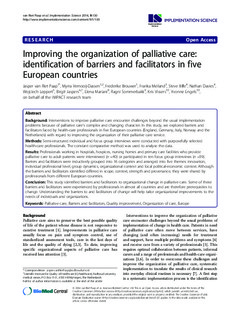| dc.contributor.author | Paap, Jasper van Riet | |
| dc.contributor.author | Vernooij-Dassen, Myrra | |
| dc.contributor.author | Brouwer, Frederike | |
| dc.contributor.author | Meiland, Franka | |
| dc.contributor.author | Liffe, Steve | |
| dc.contributor.author | Davies, Nathan | |
| dc.contributor.author | Leppert, Wojciech | |
| dc.contributor.author | Jaspers, Birgit | |
| dc.contributor.author | Mariani, Elena | |
| dc.contributor.author | Sommerbakk, Ragni | |
| dc.contributor.author | Vissers, Kris | |
| dc.contributor.author | Engels, Yvonne | |
| dc.date.accessioned | 2019-11-01T08:37:55Z | |
| dc.date.available | 2019-11-01T08:37:55Z | |
| dc.date.created | 2015-03-06T08:26:46Z | |
| dc.date.issued | 2014 | |
| dc.identifier.citation | Implementation Science. 2014, 9 (130) | nb_NO |
| dc.identifier.issn | 1748-5908 | |
| dc.identifier.uri | http://hdl.handle.net/11250/2626034 | |
| dc.description.abstract | Background Interventions to improve palliative care encounter challenges beyond the usual implementation problems because of palliative care’s complex and changing character. In this study, we explored barriers and facilitators faced by health-care professionals in five European countries (England, Germany, Italy, Norway and the Netherlands) with regard to improving the organization of their palliative care service. Methods Semi-structured individual and focus group interviews were conducted with purposefully selected health-care professionals. The constant comparative method was used to analyse the data. Results Professionals working in hospitals, hospices, nursing homes and primary care facilities who provide palliative care to adult patients were interviewed (n =40) or participated in ten focus group interviews (n =59). Barriers and facilitators were inductively grouped into 16 categories and arranged into five themes: innovation, individual professional level, group dynamics, organizational context and local political-economic context. Although the barriers and facilitators identified differed in scope, context, strength and provenance, they were shared by professionals from different European countries. Conclusion This study identified barriers and facilitators to organizational change in palliative care. Some of these barriers and facilitators were experienced by professionals in almost all countries and are therefore prerequisites to change. Understanding the barriers to and facilitators of change will help tailor organizational improvements to the needs of individuals and organizations. | nb_NO |
| dc.description.abstract | Improving the organization of palliative care: identification of barriers and facilitators in five European countries | nb_NO |
| dc.language.iso | eng | nb_NO |
| dc.publisher | BioMed Central | nb_NO |
| dc.rights | Navngivelse 4.0 Internasjonal | * |
| dc.rights.uri | http://creativecommons.org/licenses/by/4.0/deed.no | * |
| dc.title | Improving the organization of palliative care: identification of barriers and facilitators in five European countries | nb_NO |
| dc.type | Journal article | nb_NO |
| dc.type | Peer reviewed | nb_NO |
| dc.description.version | publishedVersion | nb_NO |
| dc.source.volume | 9 | nb_NO |
| dc.source.journal | Implementation Science | nb_NO |
| dc.source.issue | 130 | nb_NO |
| dc.identifier.doi | 10.1186/s13012-014-0130-z | |
| dc.identifier.cristin | 1229863 | |
| dc.description.localcode | This article is published under license to BioMed Central Ltd. This is an Open Access article distributed under the terms of the Creative Commons Attribution License (http://creativecommons.org/licenses/by/4.0), which permits unrestricted use, distribution, and reproduction in any medium, provided the original work is properly credited. The Creative Commons Public Domain Dedication waiver (http://creativecommons.org/publicdomain/zero/1.0/) applies to the data made available in this article, unless otherwise stated. | nb_NO |
| cristin.unitcode | 194,65,15,0 | |
| cristin.unitname | Institutt for klinisk og molekylær medisin | |
| cristin.ispublished | true | |
| cristin.fulltext | original | |
| cristin.qualitycode | 1 | |

